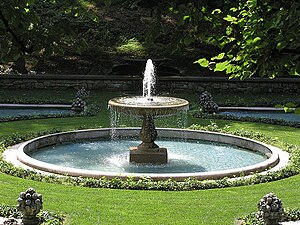A water fountain adds charm to most any setting. Whether used as the focal point in a formal garden or as a whimsical addition to a casual gathering space, an outdoor water fountain is sure to please visitors of all ages. Although there is a wide variety of ready-made outdoor water fountains available for purchase, a much more meaningful and enjoyable feature can be made from an item with sentimental value such as a hand water pump from the family farm or Grandpa’s old whiskey barrel.
To make an outdoor water fountain, the following items are needed:
- Piece that will form the basis of the water feature;
- Water source, which can be as simple as a garden hose;
- Reservoir of adequate size;
- Re-circulating pump with ample tubing and a power source; and,
- Desired supplemental decor such as plants and rocks.
Create the water fountain by positioning the main feature so that water will flow over or through it and into the reservoir. Place the pump within the reservoir and arrange the tubing to circulate the water. Once all adjustments have been made so that the water is flowing as desired, add plants, rocks and other decor in and around the fountain as the finishing touches.
Maintain the outdoor water fountain, as needed. Drain and clean the reservoir, pump and tubing at least twice each season and ensure that the working components are put into storage prior to the first freeze each fall. With proper care, an outdoor water fountain will provide years of enjoyment.
Originally from: How to create water fountain

![Reblog this post [with Zemanta]](http://img.zemanta.com/reblog_e.png?x-id=77a86d4c-08d1-4989-a998-7265fa935c53)
 [photo by:
[photo by: ![Reblog this post [with Zemanta]](http://img.zemanta.com/reblog_e.png?x-id=1678e715-c77b-4f27-94c6-deb70d48dd93)

![Reblog this post [with Zemanta]](http://img.zemanta.com/reblog_e.png?x-id=cbd546ca-d49f-4506-a013-fd5c0e212814)